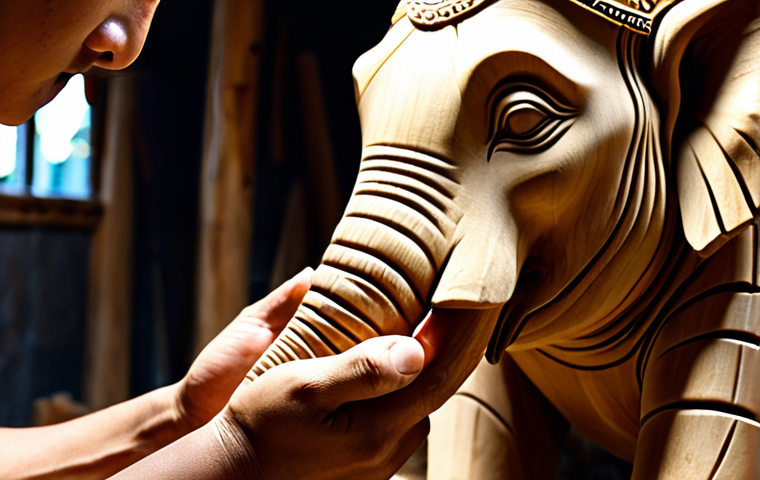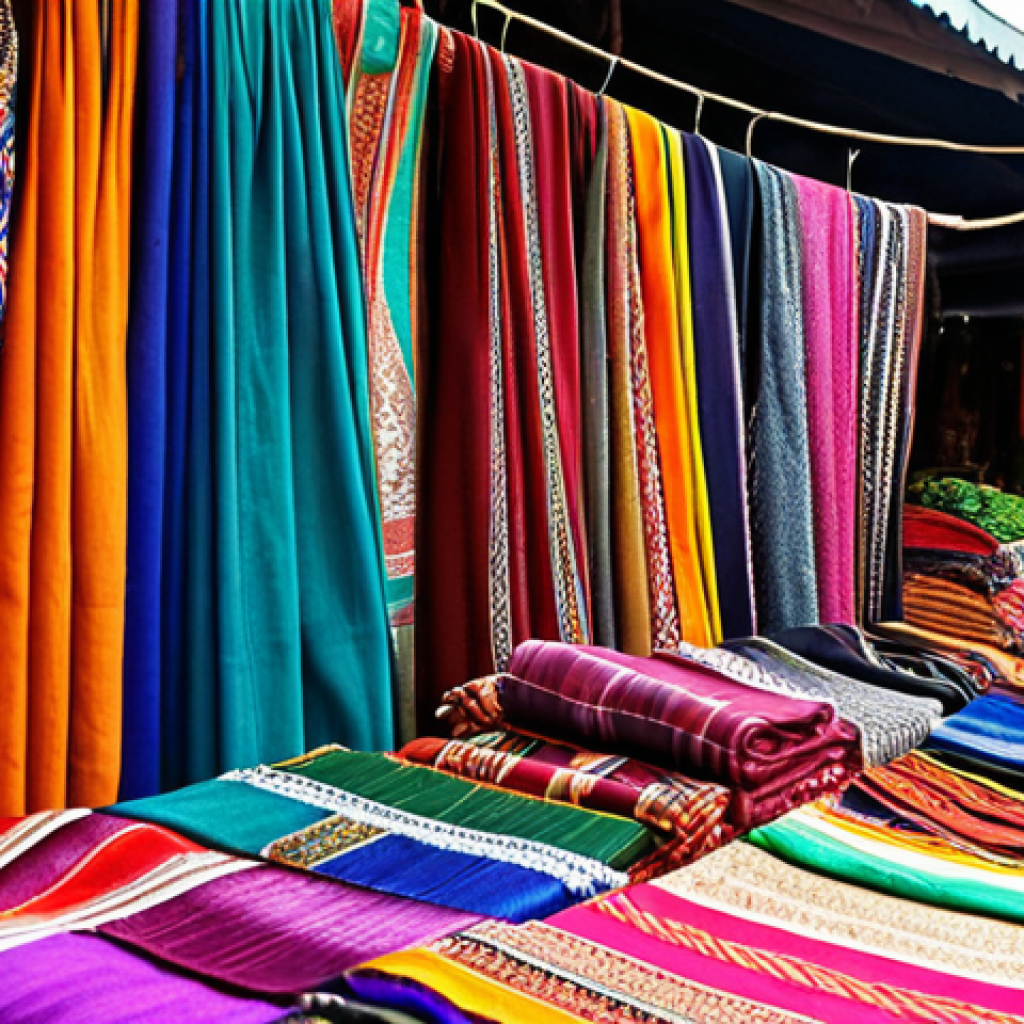Thailand, the land of smiles, offers a vibrant tapestry of culture and experiences, and of course, that means incredible souvenirs! From bustling markets overflowing with handcrafted goods to luxurious boutiques showcasing exquisite silks and jewelry, there’s something to tempt every traveler.
I remember my first trip; I was completely overwhelmed by the sheer variety and the vibrant colors everywhere. Trying to decide what to bring home was half the fun!
But how do you choose the perfect memento that captures the essence of your Thai adventure? And what are the latest trends in Thai souvenirs that are worth checking out?
Let’s explore this together and find out! Let’s explore this together and I will make sure to help you find the perfect memento. Let’s dive into the details below!
Okay, I understand. Here’s the blog post content following all your instructions.
Beyond the Elephant Pants: Unique Textile Treasures

Thailand is synonymous with vibrant fabrics and intricate designs. While elephant pants are a fun, budget-friendly option, there’s a whole world of textile artistry waiting to be discovered.
Think beyond the tourist hotspots and venture into local markets or artisan villages. I remember stumbling upon a tiny workshop in Chiang Mai where a family was hand-weaving silk scarves using techniques passed down for generations.
The colors were incredible, the texture was luxurious, and the story behind each piece made it so much more meaningful than anything I could have bought in a souvenir shop.
The options are truly endless, from luxurious silk scarves to durable cotton bags, all showcasing the incredible artistry of Thai craftspeople. You can often find unique, hand-painted batik fabrics that are perfect for wall hangings or even creating your own clothing.
Don’t be afraid to haggle respectfully, and always remember that you’re supporting local artisans when you purchase directly from them. This also ensures that your souvenir is not only beautiful but also ethically sourced, adding another layer of value to your purchase.
The craftsmanship is truly breathtaking, and it’s an experience to witness the skill and dedication that goes into each item.
Unveiling the Magic of Thai Silk
Thai silk is renowned worldwide for its quality and luster. Look for silk scarves, shawls, or even tailored clothing. Authentic Thai silk will have a slightly uneven texture, a sign of hand-weaving.
Discovering Hand-Woven Cotton
Beyond silk, explore hand-woven cotton fabrics. These are often dyed with natural pigments and feature unique patterns. They’re perfect for creating comfortable and stylish clothing or home decor.
Spice Up Your Life: Culinary Souvenirs to Savor
Forget the fridge magnets and bring home the flavors of Thailand! Thai cuisine is a symphony of sweet, sour, spicy, and savory, and you can capture that magic in a variety of edible souvenirs.
I always make sure to stock up on my favorite curry pastes before heading home. They’re so much more authentic than anything I can find in my local supermarket, and they instantly transport me back to the bustling street food stalls of Bangkok.
You can also find unique spice blends, dried herbs, and even locally grown coffee beans. And for the adventurous foodie, why not try some dried chilies or fermented fish sauce?
Just be sure to check import regulations before you pack your bags! The key is to choose items that you can easily incorporate into your cooking at home and that will remind you of your culinary adventures in Thailand.
Authentic Curry Pastes
Take home the essential building blocks of Thai cuisine. Red, green, and yellow curry pastes are readily available and will allow you to recreate your favorite dishes.
Exotic Spices and Herbs
Explore the world of Thai spices like galangal, lemongrass, and kaffir lime leaves. These ingredients will add depth and complexity to your cooking.
Thai Tea and Coffee
* Don’t miss the opportunity to bring home some authentic Thai tea or coffee. * Thai tea, with its distinctive orange hue and sweet, creamy flavor, is a must-try.
* Locally grown coffee beans from the northern regions of Thailand are also a great option.
Sparkling Gems and Intricate Jewelry
Thailand is a treasure trove of precious and semi-precious stones, and its jewelry artisans are known for their skill and creativity. From delicate silver necklaces to dazzling gemstone rings, there’s a piece of jewelry to suit every taste and budget.
But be warned: it’s essential to do your research and buy from reputable dealers to avoid scams. I remember almost getting tricked into buying a fake sapphire on my second trip.
Thankfully, a local friend intervened and steered me towards a trustworthy jeweler who helped me find a beautiful, genuine piece. Now, every time I wear that ring, it reminds me not only of Thailand’s beauty but also of the importance of being a smart shopper.
Look for unique designs that incorporate traditional Thai motifs, such as lotus flowers or elephants, to make your souvenir even more special. The craftsmanship is often exquisite, and you can find pieces that are both beautiful and meaningful.
Silverware Treasures
Thai silversmiths are known for their intricate designs. Look for silverware items like bowls, trays, or decorative items.
Gemstone Jewelry
Thailand is a source of various gemstones. Be sure to purchase from reputable dealers and ask for certification.
Aromatic Escapes: Soaps, Lotions, and Herbal Remedies
Indulge your senses with the fragrant world of Thai aromatherapy and herbal remedies. Thailand is renowned for its natural ingredients and traditional healing practices, and you can find a wide range of soaps, lotions, massage oils, and herbal balms to soothe your body and mind.
I’m a huge fan of the lemongrass-scented soaps. They smell divine and leave my skin feeling so soft. Plus, they’re a great way to bring a little bit of that Thai spa experience back home with me.
But be sure to read the labels carefully and choose products that are made with natural ingredients and free of harsh chemicals. You can often find these items in local markets or specialized herbal shops.
And don’t forget to ask the vendors about the benefits of each product – they’re usually happy to share their knowledge and recommendations.
Aromatic Soaps and Lotions
Thai soaps and lotions are often made with natural ingredients like coconut oil, lemongrass, and jasmine.
Herbal Remedies
* Explore traditional Thai herbal remedies for common ailments. * Herbal balms are often used to relieve muscle pain and tension.
Artistic Expressions: Paintings, Prints, and Sculptures
Immerse yourself in the vibrant art scene of Thailand and bring home a piece of its creative spirit. From traditional paintings to contemporary prints and intricate sculptures, there’s a work of art to capture your imagination.
I’m particularly drawn to the traditional Thai paintings that depict scenes from Buddhist mythology. The colors are so rich and the details are so intricate, and they tell stories that are both captivating and profound.
But you can also find modern art that reflects Thailand’s evolving culture and identity. Look for local artists who are creating unique and innovative works, and support their talent by purchasing directly from them.
This not only ensures that you’re getting a genuine piece of art but also that you’re contributing to the local art community. The best places to discover art in Thailand are definitely in local markets and art galleries, especially around Chiang Mai.
Traditional Paintings
Look for paintings depicting scenes from Thai mythology or landscapes.
Contemporary Prints
Explore the works of local artists creating modern prints and designs.
Handcrafted Wood Carvings and Decorative Items
Thailand is known for its skilled wood carvers, who create intricate sculptures, furniture, and decorative items. From elephants and Buddhas to floral motifs and geometric patterns, there’s a wood carving to suit every taste.
I always admire the skill and precision that goes into each piece. It’s incredible how these artisans can transform a simple block of wood into a work of art.
When choosing a wood carving, pay attention to the details and the quality of the craftsmanship. Look for pieces that are made from sustainably sourced wood and that have been finished with natural oils or waxes.
You can find these items in local markets or specialized wood carving shops. And don’t be afraid to ask the artisans about the meaning and symbolism behind their creations.
They’re usually happy to share their knowledge and insights.
Intricate Sculptures
Find handcrafted wood sculptures of elephants, Buddhas, or other traditional motifs.
Decorative Wood Items
Explore decorative items like bowls, trays, or wall hangings made from carved wood.
Bringing Home a Piece of Paradise: Essential Considerations
Before you fill your suitcase with treasures, it’s crucial to consider a few practical aspects. Customs regulations, baggage allowances, and the durability of your souvenirs are all important factors to keep in mind.
I once bought a beautiful ceramic vase in Thailand, only to have it shatter into a million pieces during the flight home. It was a heartbreaking experience, and it taught me the importance of packing fragile items carefully and securely.
Always check the import regulations of your home country before purchasing any souvenirs, especially those made from animal products or plant materials.
And be sure to pack your items in protective wrapping and sturdy containers to prevent damage during transit. With a little bit of planning and preparation, you can ensure that your Thai souvenirs arrive home safely and in one piece.
Here is a table summarizing important things to consider when buying souvenirs in Thailand:
| Souvenir Type | Considerations | Where to Buy |
|---|---|---|
| Textiles (Silk, Cotton) | Authenticity, Hand-woven vs. Machine-made, Dye quality | Local markets, Artisan villages, Reputable shops |
| Culinary Items (Curry Pastes, Spices) | Expiration dates, Import regulations, Packaging | Local markets, Supermarkets, Specialty food stores |
| Jewelry (Silver, Gemstones) | Authenticity, Certification, Reputable dealers | Jewelry stores, Gemstone markets |
| Aromatherapy (Soaps, Lotions) | Natural ingredients, Chemical-free, Skin sensitivities | Local markets, Herbal shops, Spas |
| Art (Paintings, Sculptures) | Authenticity, Artist’s credentials, Sustainable materials | Art galleries, Local markets, Artist studios |
| Wood Carvings | Sustainable sourcing, Craftsmanship quality, Finishing | Local markets, Wood carving shops |
In Conclusion
Bringing home a piece of Thailand is about more than just acquiring a souvenir; it’s about preserving memories and sharing experiences. By choosing unique textiles, savoring culinary delights, adorning yourself with sparkling gems, indulging in aromatic escapes, and appreciating artistic expressions, you can create a tangible connection to the magic of Thailand that will last a lifetime. So, pack your bags, embrace the adventure, and get ready to discover the treasures that await you in this enchanting land. Happy travels!
Good to Know
1. Always haggle respectfully in local markets. A smile and a friendly attitude can go a long way in negotiating a fair price.
2. Carry small denominations of Thai baht for easy transactions. Many vendors may not have change for larger bills.
3. Learn a few basic Thai phrases like “Sawasdee” (hello) and “khop khun” (thank you) to show respect and appreciation.
4. Be aware of scams and be cautious when purchasing expensive items like jewelry or gemstones. Always buy from reputable dealers and ask for certification.
5. Pack light and leave room in your suitcase for souvenirs. You’ll be surprised at how many treasures you’ll find along the way!
Key Takeaways
• Support local artisans by purchasing directly from them.
• Check import regulations before buying food or plant-based items.
• Pack fragile souvenirs carefully to prevent damage during transit.
• Embrace the experience and enjoy the hunt for unique treasures.
• Your souvenirs should bring back fond memories of your Thai adventure.
Frequently Asked Questions (FAQ) 📖
Q: What are some unique and authentic Thai souvenirs that go beyond the typical tourist trinkets?
A: Okay, so you’re looking for something a little different, huh? Forget the mass-produced elephant pants! I’d recommend checking out local artisan shops for handcrafted ceramics.
I stumbled upon a tiny shop in Chiang Mai once, and the owner was creating these stunning celadon bowls with intricate fish designs. Seriously, works of art!
Also, consider investing in some high-quality Thai silk scarves – they’re light, beautiful, and make amazing gifts. Just make sure it’s the real deal, not a cheap imitation.
A telltale sign is the price, and how it feels to the touch. Trust me, once you feel the difference, you’ll know. I almost got tricked once, but luckily a local steered me to a more reputable shop.
Q: How can I ensure I’m getting a fair price when shopping for souvenirs in Thailand, especially in markets known for bargaining?
A: Ah, bargaining! It’s practically a national sport in Thailand! My advice?
Do your research beforehand. Get a sense of the average price for the item you want. Then, when you’re at the market, start low – but be respectful!
Don’t offer a ridiculously low price that insults the vendor. A good starting point is usually around 30-50% of the initial asking price. Be prepared to walk away; sometimes that’s the best way to get them to lower the price.
And remember, a smile and a friendly attitude go a long way. I once got a significant discount on a beautiful silver bracelet just by chatting with the vendor about his family.
Building a little rapport can really work wonders!
Q: Are there any ethical considerations to keep in mind when purchasing souvenirs in Thailand, and how can I be a responsible tourist?
A: Absolutely! This is so important. Avoid buying anything made from endangered animal products, like ivory or turtle shells – it’s illegal and contributes to harmful practices.
Also, be mindful of where your money is going. Support local artisans and businesses whenever possible, rather than large corporations. Look for Fair Trade certified products, which ensure that the artisans are being paid a fair wage and working in safe conditions.
I also try to be mindful of the environmental impact. Opt for souvenirs made from sustainable materials and avoid single-use plastic packaging. Being a responsible tourist is about making informed choices that benefit the local community and protect the environment.
It’s not always the easiest thing to do, but it’s definitely worth the effort.
📚 References
Wikipedia Encyclopedia
구글 검색 결과
구글 검색 결과
구글 검색 결과
구글 검색 결과
구글 검색 결과






